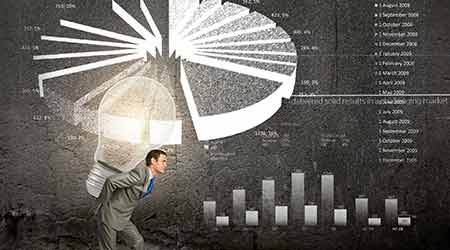5 Ways Technology Can Help Cut Energy Costs
There’s a software tool for that: From finding opportunities to save energy, to getting buy-in from
key stakeholders, to making it easier to get incentives to help pay for efficiency measures.
Providing a clear argument for the valuable role of technology in cutting energy costs is an essential strategy for building owners and facility managers. That’s because, for many organizations, reducing operating expenses, particularly utility expenses, is often a laborious and inefficient process. Numerous stakeholders need to align to strategize initiatives to meet expense reduction targets. Doing so often requires detailed reports and communication, not to mention endless meetings, before a consensus is reached.
Software systems can clarify the value of utility rebate programs and ease submission hurdles. They can empower strategic initiatives by illuminating lucrative opportunities. Additionally, utility data-sharing technology can be used to evaluate savings, and energy audits can be performed digitally and remotely. Stakeholder engagement and buy-in can also drive performance of capital expenditures through the use of technology.
1. Utility rebates
Utility rebate programs are neither consistent nor permanent. Some programs offer fixed rebates, also known as prescriptive rebates, while others offer custom rebates based on calculated energy savings — a particular dollar amount per kWh saved.
These programs can close or be put on hold at any time thus complicating any planning process. Furthermore, the process of quantifying, collecting, and applying for available rebates can be so labor-intensive that facility managers, real estate executives, and building owners often just give up and disregard rebate programs entirely.
There are emerging technology companies focusing on streamlining the process of finding, evaluating, and securing rebate funds. These technology platforms allow subscribers to enter a zip code to find the full details of utility rebate programs available to them.
Additionally, entire building portfolios can be uploaded to sites in which the software maps out the most lucrative programs available so that managers of several properties can easily target buildings in which the rebates are most attractive. This enables owners and managers to schedule work on multiple facilities in a way to take best advantage of changing local rebate programs.
Technology has made applying for rebates more accessible. As more utility companies transition to online application platforms, initiating the money-saving process has become faster and easier. Utilities eager to increase rebate program participation have made application processes much more user-friendly. And by so doing, the utilities have reduced their own manpower requirements as well. The application process has become more efficient with rebate checks passing more quickly to the ratepayer.
In addition, utility representatives are constantly promoting rebate programs online, making information more readily available. Manually submitted rebate applications require an average of 90 days to process. Online applications have reduced that timeline to 30 to 60 days, thus ensuring quicker payment.
With manual, offline rebate submittals, the process is prone to human error. Accidentally excluding a required document, such as a cut sheet, invoice, or signed application, stalls the process completely.
A simple online search or visit to an online utility portal can identify the extent to which a utility company has integrated technology into the process. Leverage online tools for quicker processing and accurate submissions.
In addition to local utility rebates, regional transmission organizations (RTOs), like PJM Interconnection, which operates the electricity wholesale market in 13 states throughout the Mid-Atlantic region, offer energy efficiency rebates above and beyond demand response. Almost any project that reduces energy consumption can qualify. These rebates are paid out quarterly for up to four years and the annual payout is about 30 percent of local utility rebates.
An approved aggregator is required to obtain these RTO rebates. Online searches make it easier than ever to locate these service providers. The aggregators collect energy saving project information, quantify rebate amounts, then bundle and submit them to the RTO. From there, the quarterly rebate checks are sent directly to the ratepayer.
2. Energy management and maintenance
The exponential increase in software platforms can seem overwhelming. Additionally, incorporating these into existing facility management software may be difficult or not possible at all. Allowing equipment failures and costly repairs resulting from deferred maintenance to dictate replacement and conservation initiatives takes its toll on repair and maintenance budgets.
There are proven technologies for uniting multiple data collection features in a single platform. These include meter data and consumption information, utility bill payments and breakdowns, localized weather information, and even recommendations and savings estimates. The aggregation of this information is especially powerful when evaluating building portfolios or multi-tenant buildings.
If convincing corporate management to subscribe to yet another software service is going to be a tough sell, facility managers may still be able to leverage them. Utility companies, property management firms, and ownership groups are purchasing licenses and providing businesses with access to these tools en masse.
These free “energy management platforms” are designed to help facility managers manage and optimize energy expenditures. The platforms offer reporting functionality across multiple sites, benchmarking, and energy efficiency recommendations. More than 30 major U.S. utility companies currently offer access to such platforms. Facility managers can reap big benefits just by tapping into the free energy tools with robust functionality offered on these platforms.
3. Data-sharing with technology
Manually tracking utility costs and usage is not only time-consuming but limiting in the actionable information it provides.
For facility managers responsible for spaces that are not individually submetered, the challenge of obtaining this data is further compounded. It is inaccurate to assume that utility spend is correlated to the percentage of the total metered space; that assumption does not account for variables like operating hours, energy-consuming system efficiency, or space utilization.
Smart meter deployment, grid modernization, and utility regulators approving anonymous data sharing with third party companies are continuing to move the needle on utility data insights.
By using the growing availability of smart submeters and tapping into the data sharing market, building owners and facility managers alike can effectively gauge the operational efficiency of their properties when compared with similar properties.
Additionally, quantifiable efficiency gaps can easily be identified to drive strategic initiatives and capitalize on the benefits that free energy management platforms and rebate programs provide.
4. Energy audits
In-person energy audits often do not engage already deployed technology systems — smart meter data, energy management systems, or online rebate platforms. Rather, they rely on the expertise of the auditors themselves and consist of manual data collection provided by facility staff to ensure accuracy of the audit’s results.
With an understanding of what energy management platforms are available through the utility company for free and those available in the marketplace, utility expense reduction plans can be formalized effectively in surprising detail.
Facility managers can home in on specific energy-consuming systems, targeting systems with the most lucrative rebate programs available where there are existing pain points like deferred maintenance or exhausted equipment lifetimes. And this can all be accomplished without the need for an in-person energy audit.
5. Occupant and upper
management engagement
To justify capital expenditures to owners and stakeholders on low to no visibility projects, facility managers need to measure and verify energy savings. But it can be difficult to communicate those savings in a way that can be easily understood by non-technical stakeholders to win their support and buy-in.
Technology can help solve this challenge. That’s especially important when energy savings depends on behavior change. Technology platforms that showcase the results of capital expenditures can boost and engage stakeholder interest and drive stakeholder buy-in and the behavior change necessary for ideal results and sustained impacts.
These platforms allow real-time and visually enticing public displays of performance results, in turn, encourages more buy-in and support of future initiatives. They deliver awareness and cement company culture by encouraging collaboration around shared goals.
By encouraging competition between departments and teams, with efforts tallied in real-time, facility managers can further drive performance metrics.
By leveraging widely available software solutions, facility managers can not only capitalize on utility rebate programs swiftly, avoiding inevitable program changes, but also maximize the entire process of developing and executing cost reduction initiatives.
Developing strategic initiatives can be enabled with data sharing and visibility into operating conditions. Justifying capital expenditures can be done without the need for in-person audits. And real-time, visually enticing public displays can foster participation around shared goals, driving performance and achieving results that can go well beyond initial estimates.
Jeff Julia is the founder of Energy Project Advisors which specializes in advising clients on utility expense reduction strategies. He is also the author of the book Navigating the Maze of Energy Efficiency Projects. He can be reached at jeff@energyprojectadvisors.com.
Email questions to greg.zimmerman@tradepress.com.
Related Topics:













